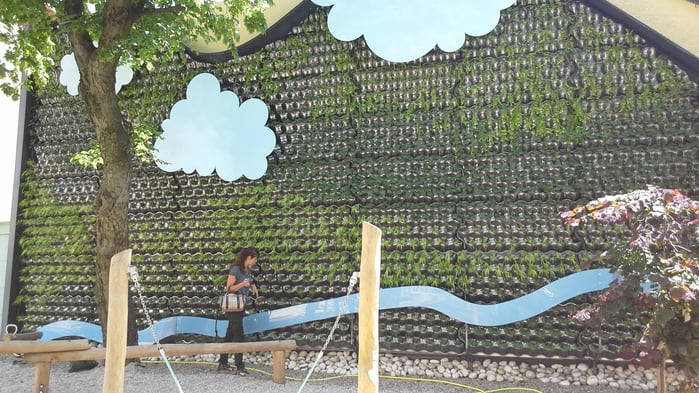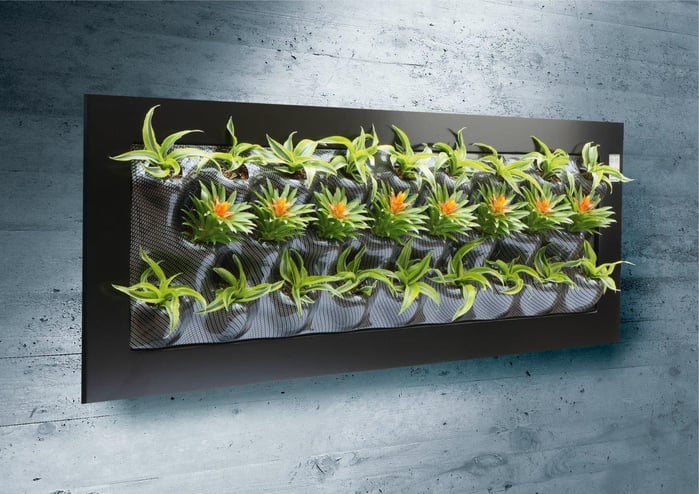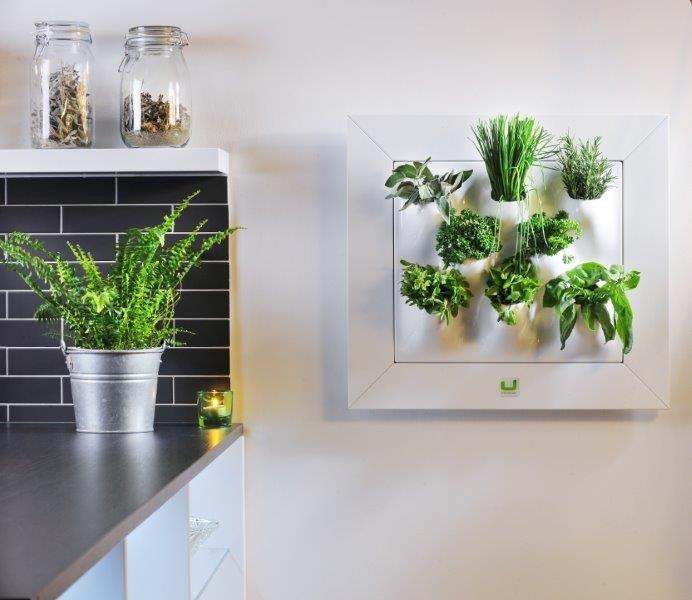Plants have been growing on building façades since the first stone was laid – but living walls represent the next generation. The father of the patent for the idea of a green wall was Stanley Hart White back in 1938. However, it was Patrick Blanc who created the most famous green wall at the Musee du Quai Branly in Paris. Since then he has been recognized as the godfather of the ‘vegetal wall’.
Although we can use many names to describe this living wall, all of these names actually describe the distinguishing feature of the green wall itself. Some people use it to cover a concrete wall and improve its appearance; and some people do not have gardens, so they use vertical gardens to harvest various crops.
Green façade vs. Green Wall
Green façades should be distinguished from green walls. A green façade employs a plant- growing medium only at the bottom of the façade, and special types of plants are used to climb all over the façade structure to make it greener. On the other hand, green walls require special types of construction panels to build it, and a vertical growing medium with its own irrigation system.
Types of growing media in living walls
By the same token, we can distinguish different growing media used to build and plant those walls.
1) Loose medium
As a loose medium we consider all types of mediums that are packed in a bag and put on the eco-wall. We can use different types of substrate mixtures with volcanic stones, pumice, vermiculite, perlite and rock mineral wool chunks or cubes. A loose medium is a natural, usually organic medium, but one not able to cope with some wall vibrations and one hard to prevent from suffering from wind up-lift, which can easily end up in small particles being blown away. It is easy to replace some plants in such a medium without damaging the other plants in the transplant process.
2) Medium in sheets
We can use polyurethane sheets, coir fiber or needled felt sheets like rock mineral wool sheet. The medium as such is easy to install on the wall the first time, or sometimes such a medium is already integrated in the panels. However, by transplanting we need to open the panel from behind and replace the medium and all the plants in the panel – especially if after some time growing the roots of the plants are well developed.
3) Structural medium
There is, however, a complete system behind a structural medium. Parts of the growing medium are made of consistent rock mineral wool, which can be incorporated into a block and then easily removed plant by plant. Such a system has certain advantages, like its own irrigation and fertilization systems, usually a pH and EC-customized system, which can be controlled. Such systems can last a long time and can, to some extent, be maintained by computer.
Benefits of green walls
Green walls can improve air quality
There are many toxins that leech, such as trichloroethylene, carbon monoxide and benzene. On the other hand, it’s well known that office plants can improve indoor air quality, so we assume that green walls can do it on a far bigger scale.
Visual benefits of living walls
Each wall is specifically designed using different varieties of plants, which can vary in color to create a living modern environment. It can improve the appearance of the building and cover the monotony of grey concrete walls inside or out.
Protecting buildings from the impacts of nature
Green walls protect buildings from natural impacts like temperature fluctuations, and keep walls sheltered from heavy rain and UV radiation.
Reducing energy costs
Living walls protect brick or concrete walls from overheating with the shade they provide. And plants do not store solar energy – they reflect it. And by covering walls with panels in winter we insulate the building, which reduces heating costs.
Reducing noise levels
Vegetation naturally blocks or absorbs high frequency sounds, while the panel structure can reduce low-frequency noise.
Increasing property values
By earning more LEED credits for reducing the heat island effect (UHI), improving water efficiency and storm water management, property values are sure to rise. Similarly, buildings with improved carbon footprints are perceived more positively.
Feeling well and improving working morale
Having green walls in a workspace can improve working morale and increase job satisfaction. And the owners or management can also share in some positive attitude and perception, demonstrating their concern by providing their employees with a healthy working environment.
Grow food
We can also grow food on a green wall, especially if we live in an apartment and do not have a big garden outside. No more excuses – now you can have your own garden by having a green wall.
Why green infrastructure and how does it help? The quality of life in cities clearly depends considerably on environmental conditions in the surroundings and beyond. Green infrastructure reduces the amount of stormwater and treats it at source, and can mitigate the frequency and intensity of unwanted events. In dense urban environments, properly planned and managed green areas can also help improve air quality and reduce excessive heat. Check also other benefits of green infrastructure.
Green walls can contribute to final Green Building Ratings
| Green walls can contribute to LEED (Leadership in Energy and Environmental Design) Certification. Gain additional LEED credits by using green wall technology in combination with other sustainable building elements. In landscape design, they can be used to reduce both the effects of solar reflection and reduce the Urban Heat Island effect (UHI). Installing green walls improves water efficiency in landscaping, and storm water collection for irrigation systems, capturing water and recycling and reducing wastewater can also add some points. Green walls can even help optimize energy performance by providing some additional insulation and natural cooling effects. Last but not least, green walls can earn LEED points by introducing innovation and design to the structure concerned. |  |
Interested in Green walls? Would you like to invest in your own Green wall? Download our Landscaping brochure and learn more about smart solutions and growing mediums based on rock mineral wool fibres.






